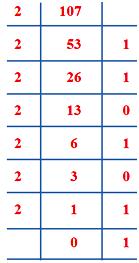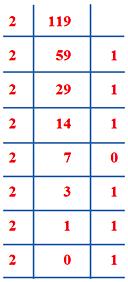Subscribe to our ▶️ YouTube channel 🔴 for the latest videos, updates, and tips.
Systems of Numeration
We know two systems of numeration.
(i) Hindu-Arab System of numbers based on 10 digits, i.e., 0, 1, 2, 3, 4, 5, 6, 7, 8 and 9.
(ii) Roman System of numbers based on 5 digits, i.e., I, V, X, L, C, D and M.
The numbers based on 10 digits and 5 digits may be interchanged.
(iii) There is a third system of numbers named as computer system. This system of numbers is based on two digits, i.e., 0 and 1.
This system is also called 2-digit based number system.
The numerals of numbers in the three systems are as follows.
10-digit-based numbers: 358293, 934528
5-digit-based numbers: XL, CDXXVI, MMC
2-digit-based numbers: 1101011, 1101111
The two-digit based numbers and 10-digit based numbers may be interchanged.
In 10-digit based numbers, the place values from right to left are as follows:
In 2-digit based numbers, the place values from right to left are given below.
Let there be a 2-based number (1101011)2 and we have to write it as a 10-based number:
The 2-based number is written in its extended form (i.e., according to the place value) as shown here:
Therefore, Number = 64 + 32 + 0 + 8 + 0 + 2 + 1 = 107= (2-based number) 1101011 = (10-based number) 107
In short 2-based number 1101011 may be changed into 10-based number
Therefore, Number = 64 + 32 + 0 + 8 + 0 + 2 + 1 = 107 = (2-based number) 1101011 = (10-based number) 107
In short 2-based number 1101011 may be changed into 10-based number
(1101011)2 = 1 x 26 + 1 x 25 + 0 x 24 + 1 x 23 + 0 x 22 + 1 x 21 + 1 x 20
= (1 x 64) + (1 x 32) + (0 x 16) + (1 x 8) + (0 x 4) + (1 x 2) + (1 x 1)
= 64 + 32 + 0 + 8 + 0 + 2 + 1
= (107)10
The 10-based number may also be changed into 2-based number.
Say, we have to change (107)10 into 2-based number.
2-based number = 11010111
(i) 107 is divided by 2, quotient is 53 the remainder is 1.
This remainder 1 is the digit of 2-based number having place 20 = 1
(ii) 53 is divided by 2, quotient is 26 the remainder is 1, it is the digit of 2-based number having place value 21 = 2
(iii) 26 is divided by 2, quotient = 13, R = 0.
Remainder 0 has the place value 22 = 4 where 0 x 4 = 0
(iv) 13 is divided by 2, quotient = 6, R = 1, place value = 23 = 8, 1 x 8 = 8
(v) 6 is divided by 2, Quotient = 3, R = 0, place value of 0 = 24, 0 x 16 = 0
(vi) 3 is divided by 2, quotient = 1, R = 1, place value of 1 x 25 = 1 x 32 = 32
(vii) 1 is divided by 2, quotient = 0, R = 1,place value = 1 x 26 = 1 x 64 = 64
Therefore, (107)10 = (1101011)2
2-based number = 1101011
10-based number = 64 + 32 + 0 + 8 + 0 + 2 + 1 = (107)10
Say we have to change (119)10 into 2-based number.
Verification
1 1 1 0 1 1 1
= 26 + 25 + 24 + 23 + 22 + 21 + 20
= 64 + 32 + 16 + 0 + 4 + 2 + 1
= 119
2-based number= 1110111 |
10-based number= 64 + 32 + 16 + 0 + 4 + 2 + 1 |
Related Concept
● Patterns and Mental Mathematics
● Counting Numbers in Proper Pattern
● Puzzle
● Patterns
From Systems of Numeration to HOME PAGE
Didn't find what you were looking for? Or want to know more information about Math Only Math. Use this Google Search to find what you need.







New! Comments
Have your say about what you just read! Leave me a comment in the box below. Ask a Question or Answer a Question.